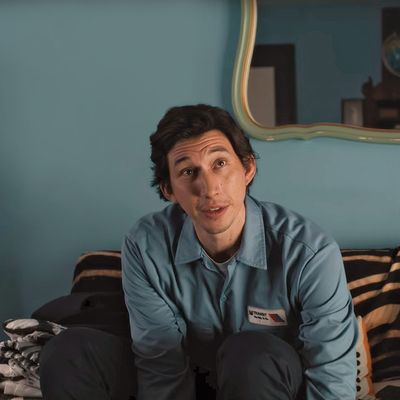
Jim Jarmusch’s Paterson depicts one week in the mundane but highly symbolic life of a Paterson, New Jersey, bus driver and poet (Adam Driver) whose name also happens to be Paterson. He wakes up at the same time on all but one of the film’s weekdays (he has an internal clock); kisses his wife, Laura (Golshifteh Farahani); and walks to the bus depot, sometimes stopping in front of the Great Falls to sit and write. As he waits for his supervisor’s signal to begin his route, he pulls out his notebook and scribbles lines of poetry that appear onscreen in an elegant scrawl while he speaks them aloud. One poem uses a box of matches (Ohio Blue Tip) as a springboard to depicting love, from the slant of the letters to the gesture of lighting a cigarette. On the bus, Paterson listens to different sorts of people having intense conversations behind him. He notices patterns in passersby, many of whom happen to be twins. He’s in a porous, meditative state, an alert trance. In the evenings, after dinner, he parks his little bulldog, Marvin, in front of a bar and nurses a beer while dramas — among them the plight of a rejected lover (William Jackson Harper) — erupt around him. He chats with the bartender, Doc (Barry Shabaka Henley), about the photos on the wall depicting former Paterson residents, including Lou Costello, Allen Ginsberg, and, of course, William Carlos Williams.
“Paterson lies in the valley under the Passaic Falls / its spent waters forming the outline of his back,” wrote Williams in the first installment of his epic poem, “Paterson,” which he began in 1926 and hadn’t finished when he died nearly four decades later. Williams’s long first part is, in any case, the best, cementing his documentarist impulses: “I took the river as it followed its course down to the sea; all I had to do was follow it and I had a poem,” he wrote. In his film, Jarmusch follows his own river to create his own cinematic poem, but he is scrupulously faithful to Williams’s most famous tenet: “No ideas but in things.” The film is not realistic, but it is grounded.
It is also a peculiar combination of casual and deliberate, which is Jarmusch’s ever-shifting sweet spot. If you were to call him a naturalist, he’d point to all the artificial structures within his films. If you were to call him a symbolist, he’d say his aim is to evoke the texture of ordinary life. He is certainly an anthropologist. He’s attuned, in particular, to the kind of rituals that constrict in order to liberate. Paterson might be a blue-collar worker who’s tied to a potentially numbing routine, but within that routine his artistry can flourish. (This is all very Japanese — and it’s a Japanese poet who arrives out of the blue to rekindle Paterson’s creative spirit after a setback late in the film.) In depicting Paterson’s day-to-day rituals, Jarmusch evokes something essential about the artist’s way: how he or she must seesaw between observation and insularity, maintaining a firm sphere of privacy while being open to everything. I’ve never seen a film that captures the inner world of an artist with such delicacy.
Driver’s driver Paterson in Paterson registers as a very odd man out, and not just because he’s the only grown white male in a cast composed of black, Indian, Iranian, and Japanese actors. While Jarmusch’s protagonists tend to be on the impassive side, the actor has the least-dead deadpan imaginable. It’s not that he pulls faces. It’s that nature has already pulled his face in all sorts of interesting directions, so that the normal flow of thought creates unusual ripples. Driver’s Paterson never seems to think harder than when he’s overhearing other people. When someone formally engages him, those huge features freeze and he can’t find the words to express what’s in his head. Paterson opens himself only once, when he meets a little girl (Sterling Jerins) who identifies herself as a poet and reads him an astonishing poem that begins, “Water falls from the bright air / It falls like hair / Falling across a young girl’s shoulders.” In her, he recognizes a fellow Williams-like extrapolator of large ideas from small things.
The most unresolved aspect of Paterson is Paterson’s marriage and what on earth we’re supposed to make of it. The Iranian actress Farahani maintains a lively patter while designing black-and-white clothes or black-and-white cupcakes, but her Laura is a bit like Eva Gabor in the sitcom Green Acres: dizzily beautiful and completely untethered. For a while, I thought she’d turn out to be a phantom — until I realized that everyone in the movie is a kind of a phantom in Paterson’s consciousness. The couple goes out once together, to see the 1932 Island of Lost Souls, after which Paterson compares Laura to the feral, fractured-English-speaking Panther Woman. (“You guys could be twins.”) Then they discover that while they were gone, the dog ripped Paterson’s notebook to pieces. The message is clear: A marriage takes an artist away from — and potentially threatens — his or her work. Also, Paterson, Laura, or both are lost souls.
What Jarmusch hasn’t attempted in his Paterson is to explore the part of the city that was called, when Williams wrote about it, “the slums.” Perhaps he felt that abject poverty wouldn’t suit his slightly ironic distance, that it would rip the film’s fragile fabric. It might have, but without that edge this Paterson comes close to seeming twee, like one of Wes Anderson’s dollhouse communities. The poems make all the difference, transforming the most amorphous yearnings into something hard and beautiful and real.
*This article appears in the December 26, 2016, issue of New York Magazine.


